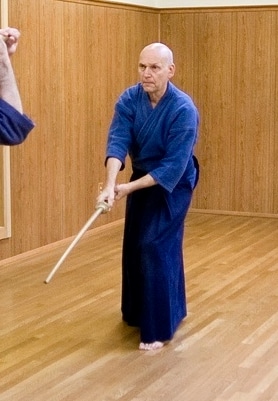
Shinto Muso-ryu Jo (Jodo / Jojutsu) is what we study, and are authorized to teach, under the direct tutelage of Phil Relnick, Menkyo Kaiden. Relnick Sensei was a student of Shimizu Takaji Sensei and Nishioka Tsuneo Sensei.
Relnick Sensei spent over 40 years living and working in Japan after serving in the US Air Force. He is a graduate of Waseda University, and earned his Masters of Asian Studies from the University of Michigan. Relnick Sensei worked for several large Japanese companies before starting his own business consulting practice in Tokyo. During this time his primary martial arts studies included Kodokan Judo, Shinto Muso Ryu Jo, and Tenshinsho-den Katori Shinto Ryu.
His first mentor and Sempai in Japan was Donn Draeger Sensei. Draeger Sensei was becoming well known for writing many articles and books about classical Japanese martial arts. When it came time for Relnick to relocate to Japan after his service time, he reached out to Draeger Sensei for assistance. Draeger Sensei was already a student of Shimizu Sensei, introducing Relnick to Shimizu Sensei in 1962. At that time Relnick began Shinto Muso-ryu under Shimizu Sensei at the Tomisaka Police Dojo, and later the Tokyo Rembukan Dojo.
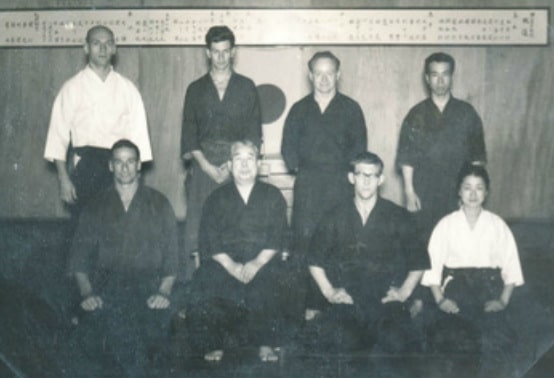
Tokyo Rembukan Dojo
back L-R: Phil Relnick, Quintin Chambers, Chic Eather, Kobayashi S.
front L-R: Don Draeger, Shimizu Takaji Sensei, Marten Gravenstein, Nobuko Relnick
Shinto Muso Ryu Jo (Jodo / Jojutsu) is what we study, and are authorized to teach, under the direct tutelage of Phil Relnick, Menkyo Kaiden. Relnick Sensei was a student of Shimizu Takaji Sensei and Nishioka Tsuneo Sensei.
Relnick Sensei spent over 40 years living and working in Japan after serving in the US Air Force. He is a graduate of Waseda University, and earned his Masters of Asian Studies from the University of Michigan. Relnick Sensei worked for several large Japanese companies before starting his own business consulting practice in Tokyo. During this time his primary martial arts studies included Kodokan Judo, Shinto Muso Ryu Jo, and Tenshinsho-den Katori Shinto Ryu.
His first mentor and Sempai in Japan was Donn Draeger Sensei. Draeger Sensei was becoming well known for writing many articles and books about classical Japanese martial arts. When it came time for Relnick to relocate to Japan after his service time, he reached out to Draeger Sensei for assistance. Draeger Sensei was already a student of Shimizu Sensei, introducing Relnick to Shimizu Sensei in 1962. At that time Relnick began Shinto Muso ryu Jo under Shimizu Sensei at the Tomisaka Police Dojo, and later the Tokyo Rembukan Dojo.

Tokyo Rembukan Dojo
back L-R: Phil Relnick, Quintin Chambers, Chic Eather, Kobayashi S.
front L-R: Don Draeger, Shimizu Takaji Sensei, Marten Gravenstein, Nobuko Relnick
Below is an abridged lineage of Shinto Muso Ryu Jo from establishment in the early 1600s until today.

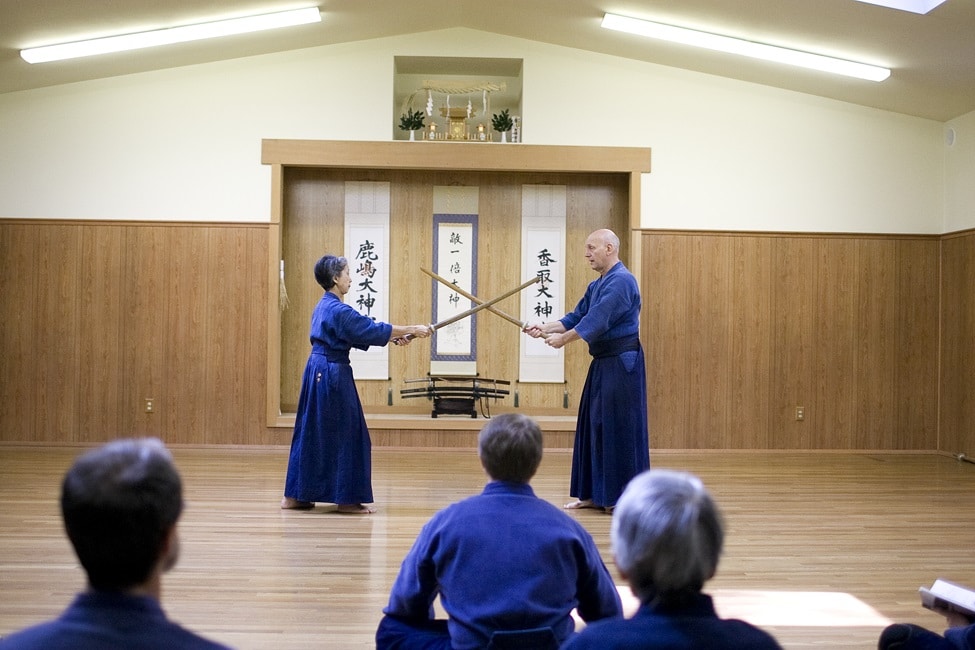
Through this extensive time living/working/studying in Japan directly from Koryu teachers, Relnick Sensei developed a truly deep understanding of the Japanese martial arts and culture.
Relnick Sensei assisted Shimizu Sensei and Draeger Sensei in establishing the International Jodo Federation (IJF), which helped spread Jo to Asia, the Americas, and to Europe. Draeger Sensei was the first IJF president, Relnick Sensei followed him as the second. He continued to study Shinto Muso-ryu under Nishioka Tsuneo Sensei after Shimizu Sensei’s passing in 1978.
Relnick Sensei was an early researcher/student under Draeger Sensei during the formation of the International Hoplology Society. Relnick Sensei was also founder and first president of the Japan Martial Arts Society (JMAS), and Pan-American Jodo Federation.
Relnick Sensei invited Nishioka Sensei to join and teach at various IJF events. Nishioka Sensei, being an early/pre-war student of Shimizu Sensei, brought forward a clarity regarding the importance of Uchidachi (the swordsman) in the kata of Shinto Muso Ryu. This helped revitalize many aspects of both Jo and swordsmanship use within Shinto Muso-ryu. Nishioka Sensei often said ‘a poor swordsman will produce a poor Jo man’, in an effort to highlight the need for highly skilled swordsmanship within Shinto Muso-ryu.
Relnick Sensei is a also Shidosha-Menkyo in Tenshinsho-den Katori Shinto Ryu and a direct student of Otake Risuke Sensei. Today he teaches Shinto Muso-ryu Jo and Katori Shinto-ryu at his Shintokan Dojo in Woodinville, Washington.
Through this extensive time living/working/studying in Japan directly from Koryu teachers, Relnick Sensei developed a truly deep understanding of the Japanese martial arts and culture.
Relnick Sensei assisted Shimizu Sensei and Draeger Sensei in establishing the International Jodo Federation (IJF), which helped spread Jo to Asia, the Americas, and to Europe. Draeger Sensei was the first IJF president, Relnick Sensei followed him as the second. He continued to study Shinto Muso-ryu under Nishioka Tsuneo Sensei after Shimizu Sensei’s passing in 1978.
Relnick Sensei was an early researcher/student under Draeger Sensei during the formation of the International Hoplology Society. Relnick Sensei was also founder and first president of the Japan Martial Arts Society (JMAS), and Pan-American Jodo Federation.
Relnick Sensei invited Nishioka Sensei to join and teach at various IJF events. Nishioka Sensei, being an early/pre-war student of Shimizu Sensei, brought forward a clarity regarding the importance of Uchidachi (the swordsman) in the kata of Shinto Muso-ryu. This helped revitalize many aspects of both Jo and swordsmanship use within Shinto Muso-ryu. Nishioka Sensei often said ‘a poor swordsman will produce a poor Jo man’, in an effort to highlight the need for highly skilled swordsmanship within Shinto Muso-ryu.

Relnick Sensei is a also Shidosha-Menkyo in Tenshinsho-den Katori Shinto Ryu and a direct student of Otake Risuke Sensei. Today he teaches Shinto Muso-ryu and Katori Shinto-ryu at his Shintokan Dojo in Woodinville, Washington.

Lineage of Shinto Muso-ryu tradition – Founded early 1600s [1]
(1). Iizasa Choisai Ienao 飯篠長威齋家直
(1387–1488) Founder of Katori Shintō-ryū.
(2). Matsumoto Bizen-no-kami Masanobu 松本備前守政信
(1467–1524) Founder of Kashima Jikishinkage-ryū and Kashima Shinryū
1. Muso Gonnosuke Katsuyoshi
夢想權之助勝吉 – Traditional founder of “True Path” 真道 (Shinto) Muso-ryu. Studied Katori Shinto ryu & Kashima Jikishinkage ryu.
2. Okubi Mogozaemon Yoshishige 小首孫左衛門吉重 (also known as Kokubi Magozaemon Yoshishige)
3. Matsuzaki Kin’emon Shigekatsu – 松崎金右衛門重勝 Credited [3] with creating two new separate arts which are taught alongside SMR – Also a practitioner of Itto-ryu Kenjutsu.
4. Higuchi Han’emon Katsunobu – 樋口半右衛門勝信 The last Headmaster of a unified SMR – Separate lineages of Gonnosukes Jō-art appear, headed by their own headmasters.
The “New Just” 新當 (Shinto) Muso-ryu tradition
5. Harada Heizo Nobusada (died 1733) – Establishes the “New Just” 新當 (Shintō ) Musō-ryū tradition. (informally known during this period as “Kansai-ryū” which is a reference to a title of Harada Heizo.)
6. Hara Shiemon Ujisada (died 1754)
7. Nagatomi Koshiro (1717–1772), last Headmaster of “The New Just” – On his death, The “New Just” 新當 (Shintō) Musō-ryū branches of into two new lines headed by students of the last “New Just” headmaster.
The “True Path” 真道 (Shinto) Muso-ryu tradition- Later known as Moroki-ryu
5. Yokota Hanzaburo – Continues the original “True Path” 真道(Shintō) Musō-ryū.
6. Moriki Keichi (died 1784) – Establishes Moriki-branch (Moroki-ryū).
7.Inoue Ryosuke (died 1821) – Line broken with his death.
Haruyoshi branch
8.Ono Kyusaku Tomotoki (died 1807) – Establishes Haruyoshi branch of “New Just” 新當 (Shintō) Musō-ryū around 1796.
9. Nagatomi Jinzo Yusai (died 1822)
10. Hirano Kichizo Noei (died 1871)
11. Yoshikawa Wataru Toshimasa
12. Hirano Saburo, (1837–1916) – Last Headmaster of the Haruyoshi – Tradition merged with the “Jigyo” tradition to form the “Way of the gods” 神道 (Shintō) Musō-ryū later under Shiraishi Hanjiro
Jigyo branch
8. Komori Seibei Mitsuaki Establishes Jigyo branch of “New Just” 新當 (Shinto) Muso-ryu around 1796.
9. Fujimoto Heikichi Norinobu (died 1815) – Line broken with his death in 1815.
10. Hatae Kyuhei Norishige (died 1829) – Originally from the Haruyoshi-tradition – Reestablishes Jigyo-branch.
11. Yoshimura Hanjiro – Last Headmaster of “Jigyo” – Tradition merged with the “Haruyoshi” tradition to form the “Way of the gods” 神道 (Shintō) Musō-ryū later under Shiraishi Hanjiro.
The “True Path” 真道 (Shinto) Muso-ryu tradition- Later known as Moroki-ryu
8. Hatae Kyuhei – Line reestablished.
9.Yamazaki Koji – Last Headmaster of “True Path” 真道 (Shintō) Musō-ryū. Named “Shujo-ryū” by its last Headmaster – Line broken in the Bakumatsu era, (1850–1867), never reestablished.[2]
“Way of the gods” 神道 (Shinto) Muso-ryu – late 19th century to present time
Jigyo and Haruyoshi branches joined into a single ryu.
24. Shiraishi Hanjiro Shigeaki (1842–1927) – Was originally a lower class warrior and exponent of both the “Haruyoshi” and “Jigyo” traditions.[1] After the fall of the Tokugawa and the Feudal-system, Shiraishi is issued a joint-license of the largest two surviving branches of the Kuroda-jō, the “Haruyoshi” and “Jigyo”-branch. The result of the merge is a new single tradition that was named “Way of the Gods” 神道 (Shinto) Muso-ryu, with Shiraishi being the sole leader by the early 1900s. Shiraishi was considered the arts 24th headmaster.
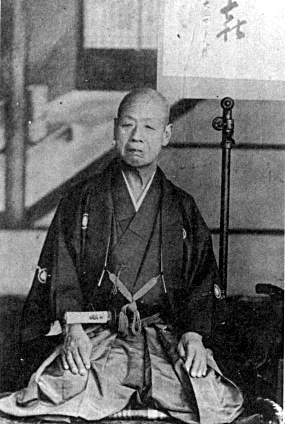
Shiraishi Hanjiro [1]
25. Shimzu Takaji (1896–1978) – A student of Shiraishi Hanjiro. Is considered by some to be the 25th[5] headmaster of Shintō Musō-ryū. Responsible for bring Shinto Muso-ryu out of Kyushu and to a wider audience in Japan, and eventually around the world.
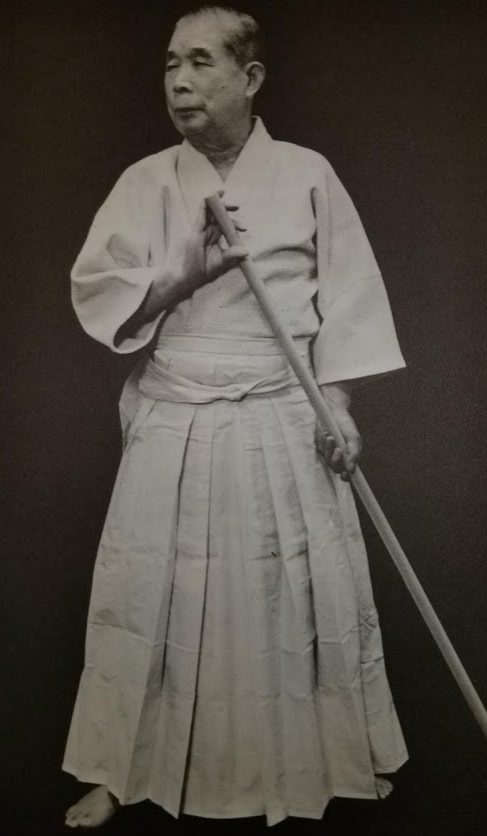
Shimizu Takaji [1]
26. A 26th headmaster has never been formally appointed by a unified SMR-community. Otofuji Ichizo is sometimes mentioned in this capacity but it was never formally recognized. Otofuji Sensei remained in Fukuoka after Shimizu Sensei left for Tokyo, and continued to teach Kyushu-focused Shinto Muso Ryu until passing away in 1999.
Nishioka Tsuneo (1924-2014) – Began training at the age of 14 in 1938 with Shimizu Takaji Sensei and studied with Shimizu Sensei until his passing in 1978. Nishioka Sensei created the Sei Ryu Kai in honor of Shimizu Takaji Sensei.
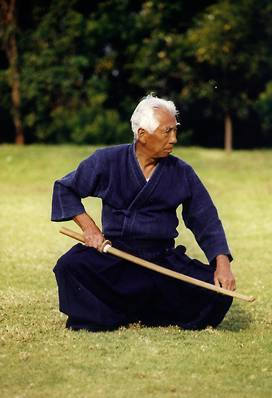
Phil Relnick (b1938) – a student of Shimizu Takaji Sensei & Nishioka Tsuneo Sensei, began studying Jo in 1962 at the Tomisaka Police Dojo, and Tokyo Rembukan Dojo under Shimizu Takaji Sensei. He continued his Jo training under Nishioka Tsuneo Sensei after Shimizu Takaji Sensei’s passing in 1978. Today he teaches Shinto Muso-ryu Jo and Tenshinsho-den Katori Shinto-ryu at his Shintokan Dojo in Washington state.
The name “Taiseikai [泰 清 会] is an informal group name under which the students of Phil Relnick study Shinto Muso-ryu Jo. This honors both Shimizu Takaji and Nishioka Tsuneo. The first kanji 泰 is read ‘Tai’ or ‘Yasu’, and it appears in the martial name of both men. The second kanji 清 ‘Sei’, is also pronounced ‘Shi’, and is the first character in Shimizu Sensei’s name. ‘Kai’ 会 means ‘group’.

Lineage information: Within Shinto Muso-ryu Jo there are actually numerous valid lineages today, and not a single headmaster, as is found in some other Japanese koryu martial systems. ‘Menkyo kaiden’ is the style’s highest level of recognition and these exponents are the only people qualified to teach and promote other exponents of Shinto Muso-ryu Jo. While it is not unusual today to have more than one menkyo kaiden within a group, organization, or even a dojo, the reality is that each one of them is able to make their own decisions about how/where/why Shinto Muso-ryu Jo should be transmitted. If we look at the history of Shinto Muso-ryu we can see that even near the beginning there were several menkyo kaiden involved. After the Meiji Restoration and the spread of Shinto Muso-ryu outside of Kyushu, eventually several people (many Japanese and a few foreigners) have received menkyo kaiden. And those people continue the transmission of Shinto Muso-ryu Jo as a valid lineage. Phil Relnick Sensei was the first foreigner to receive a menkyo kaiden, and the lineage you see here simply reflects OUR line of study and transmission of Shinto Muso-ryu Jo.
References
1. Wikipedia – History of Shinto Muso Ryu
2. Matsui, Kenji. 1993. The History of Shindo Muso Ryu Jojutsu, translated by Hunter Armstrong (Kamuela, HI: International Hoplological Society)
3. Krieger, Pascal – Jodô – la voie du bâton / The way of the stick (bilingual French/English), Geneva (CH) 1989, ISBN 2-9503214-0-2
